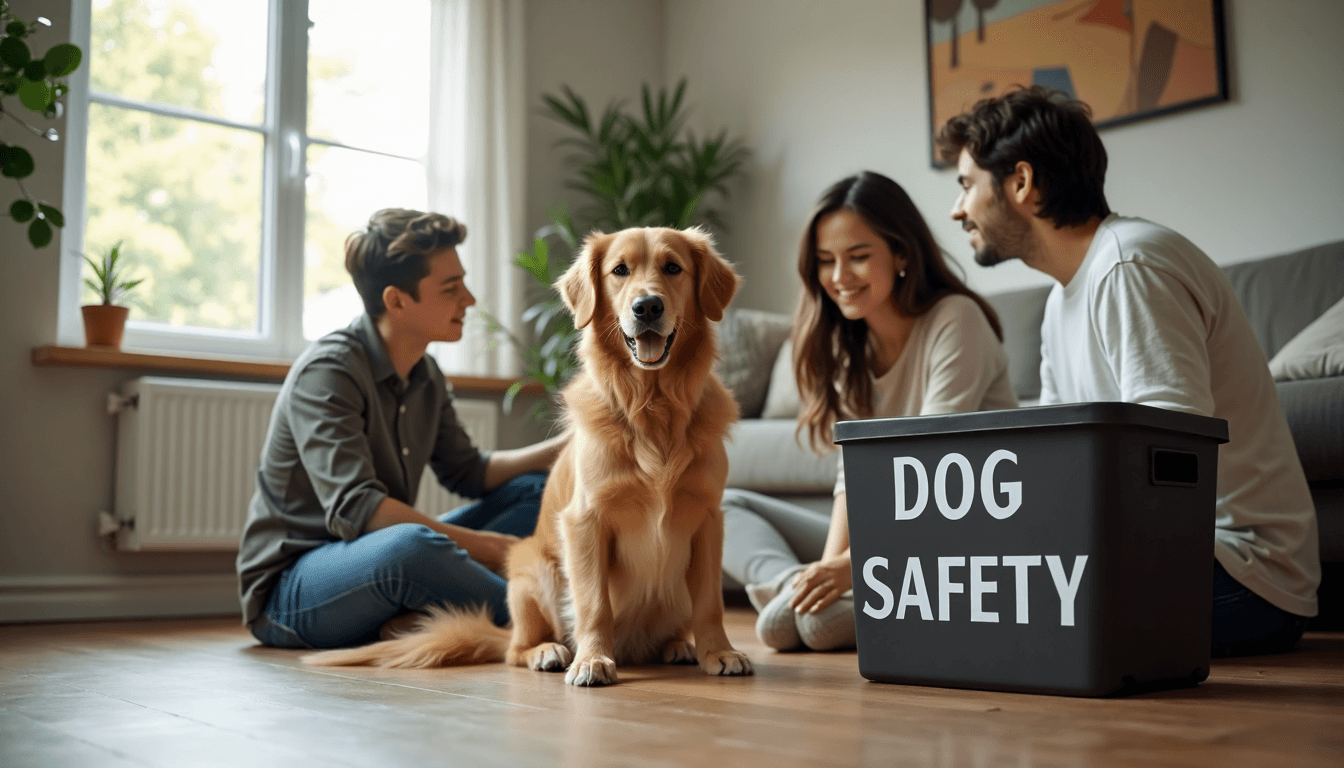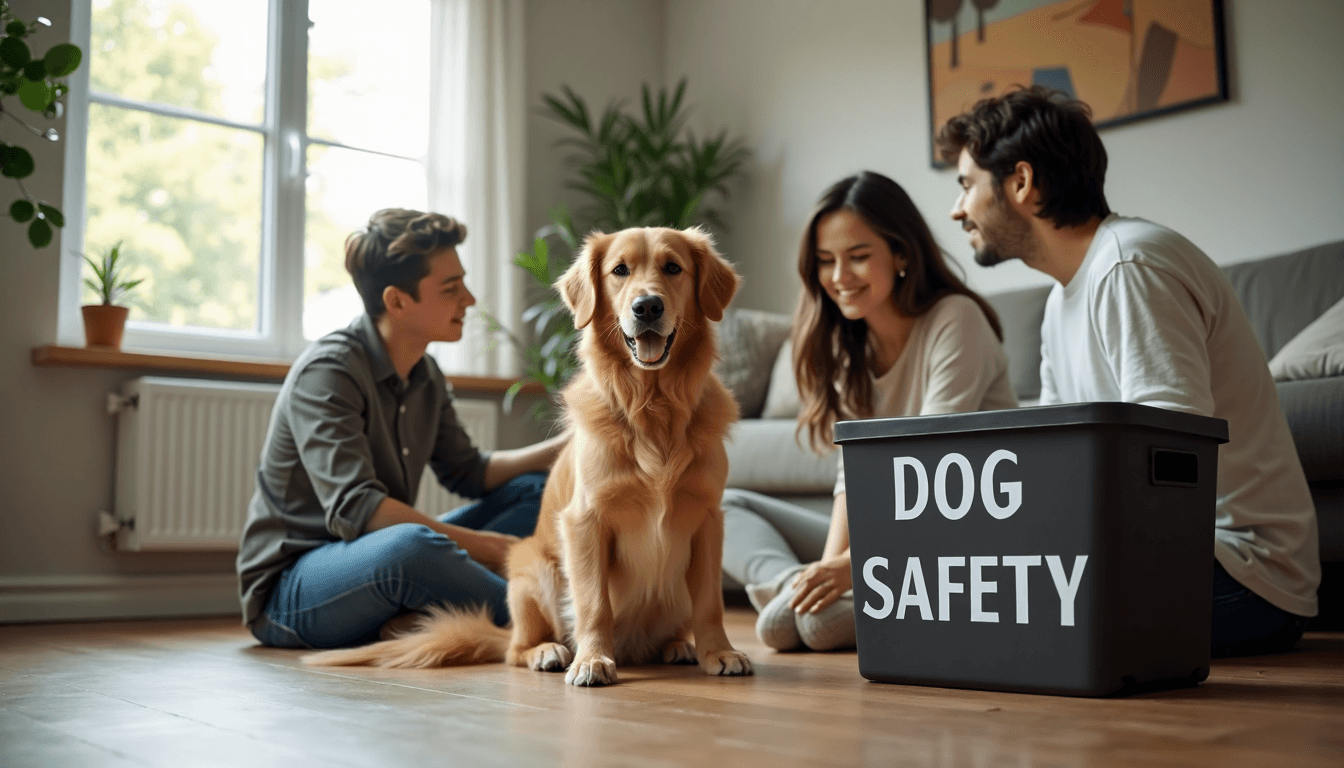
Dog safety is more than just keeping your four-legged friend indoors. Each year, over 200,000 dogs are treated for preventable injuries at home. You might think a few baby gates and tucked-away cleaners are enough to keep your pup safe. The challenge is, real canine safety demands much more attention and know-how than most owners ever realize.
Table of Contents
- Creating A Safe Home Environment For Dogs
- Outdoor Safety And Public Etiquette
- Special Considerations For Service And Senior Dogs
- Emergency Preparedness And First Aid Basics
Quick Summary
| Takeaway | Explanation |
|---|---|
| Create a Safe Home Environment | Conduct a thorough assessment of your living space to identify and eliminate hazards such as toxic substances and unsecured electrical cords. Establish designated safe areas for your dog to ensure their comfort and safety. |
| Follow Leash Laws and Manage Interactions | Always keep your dog leashed in public areas as per local laws, maintain control at all times, and learn to read dog body language to manage social interactions effectively. |
| Tailor Care for Service and Senior Dogs | Recognize the unique needs of service and senior dogs, including specialized healthcare, adaptive strategies, and consistent routines to support their well-being and quality of life. |
| Prepare for Emergencies | Assemble a comprehensive emergency kit for your dog, including food, medical records, and first aid supplies. Familiarize yourself with critical first aid techniques and create a detailed evacuation plan. |
| Ongoing Safety Monitoring | Regularly reassess your home environment and adapt safety measures as your dog ages or your living situation changes to continuously protect your canine companion. |
Creating a Safe Home Environment for Dogs
Ensuring your dog’s safety at home requires strategic planning and proactive management. Dogs rely on their owners to create an environment that protects them from potential hazards while providing comfort and security.
Understanding Home Safety Fundamentals
Creating a safe home environment begins with a comprehensive assessment of potential risks. Learn more about comprehensive dog safety strategies to minimize accidents and protect your furry companion. Dogs are naturally curious creatures who explore their surroundings using their senses, which means they can easily encounter dangerous situations without proper precautions.
According to the ASPCA, dog owners should systematically evaluate their living spaces for potential threats. This includes identifying and removing toxic substances, securing loose electrical cords, and preventing access to hazardous areas. Common household items like cleaning products, medications, and certain houseplants can pose significant risks to dogs if ingested.
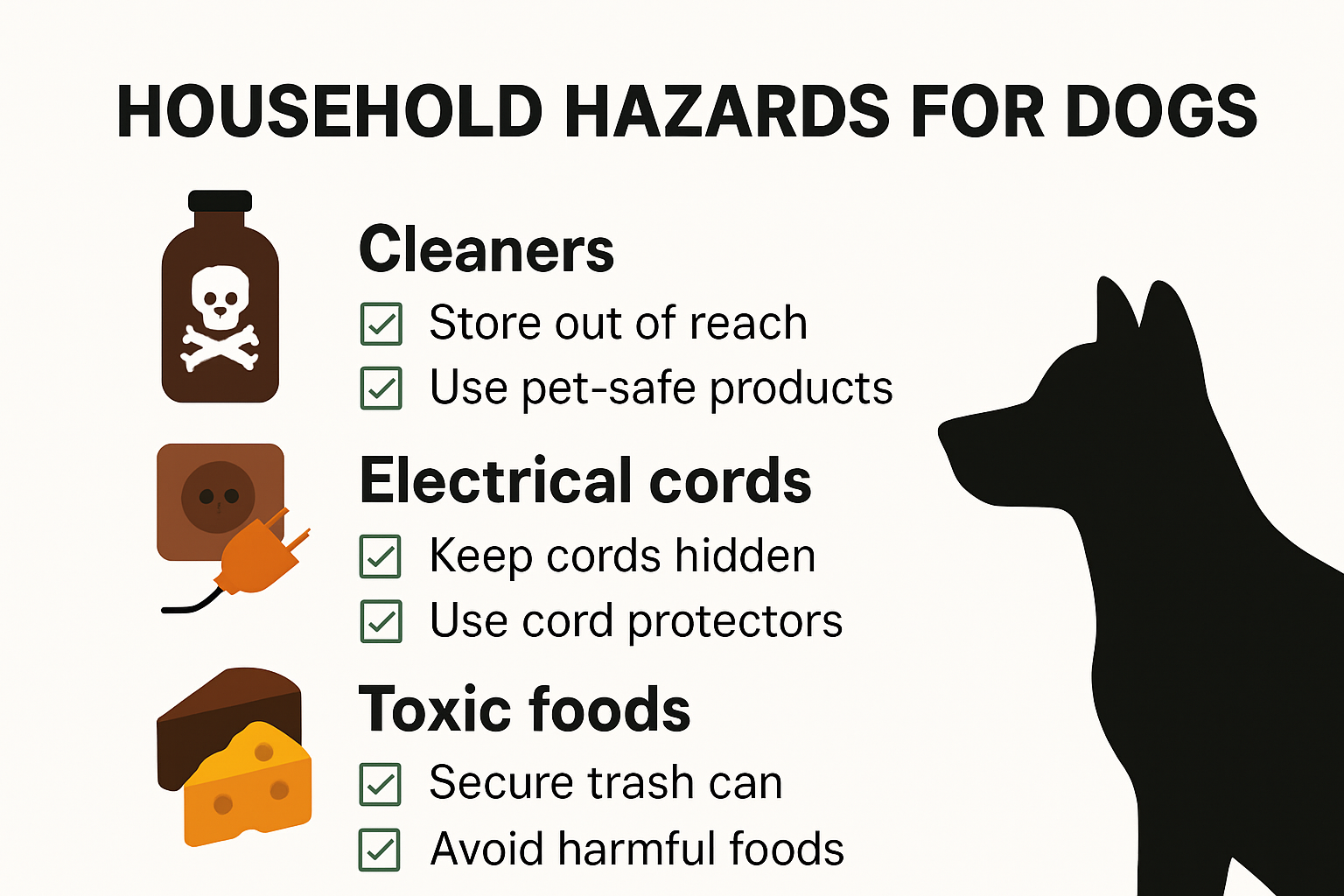
Designing a Dog Friendly Living Space
Pet-proofing your home requires a multifaceted approach. The American Veterinary Medical Association recommends creating designated safe zones for your dog. These areas should include:
- Comfortable Resting Area: A quiet, dry space where your dog can retreat and feel secure
- Controlled Access: Baby gates or closed doors to limit access to potentially dangerous rooms
- Safe Storage: Secure cabinets and high shelves to store chemicals and small objects
Ensure electrical cords are bundled and secured, trash cans have tight-fitting lids, and small objects that could be choking hazards are kept out of reach. Dogs, especially puppies and curious breeds, can quickly turn a seemingly harmless environment into a dangerous playground.
To help you assess and organize pet-proofing essentials, here’s a summary table of common household hazards and corresponding safety tips:
| Hazard | Risk Description | Safety Tip |
|---|---|---|
| Toxic Substances | Cleaning products, medications, plants can be poisonous if ingested | Store out of reach in secure cabinets |
| Electrical Cords | Dogs can chew and get shocked | Bundle and secure cords |
| Small Objects | Risk of choking or intestinal blockage | Keep small items off the floor |
| Trash Cans | Access to human food and hazards | Use cans with tight-fitting lids |
| Open Windows/Doors | Escape or fall risk | Use screens, keep closed or supervised |
| Hazardous Rooms (e.g., Garage) | Exposure to dangerous equipment or chemicals | Block access with gates or closed doors |
Ongoing Safety Monitoring and Adaptation
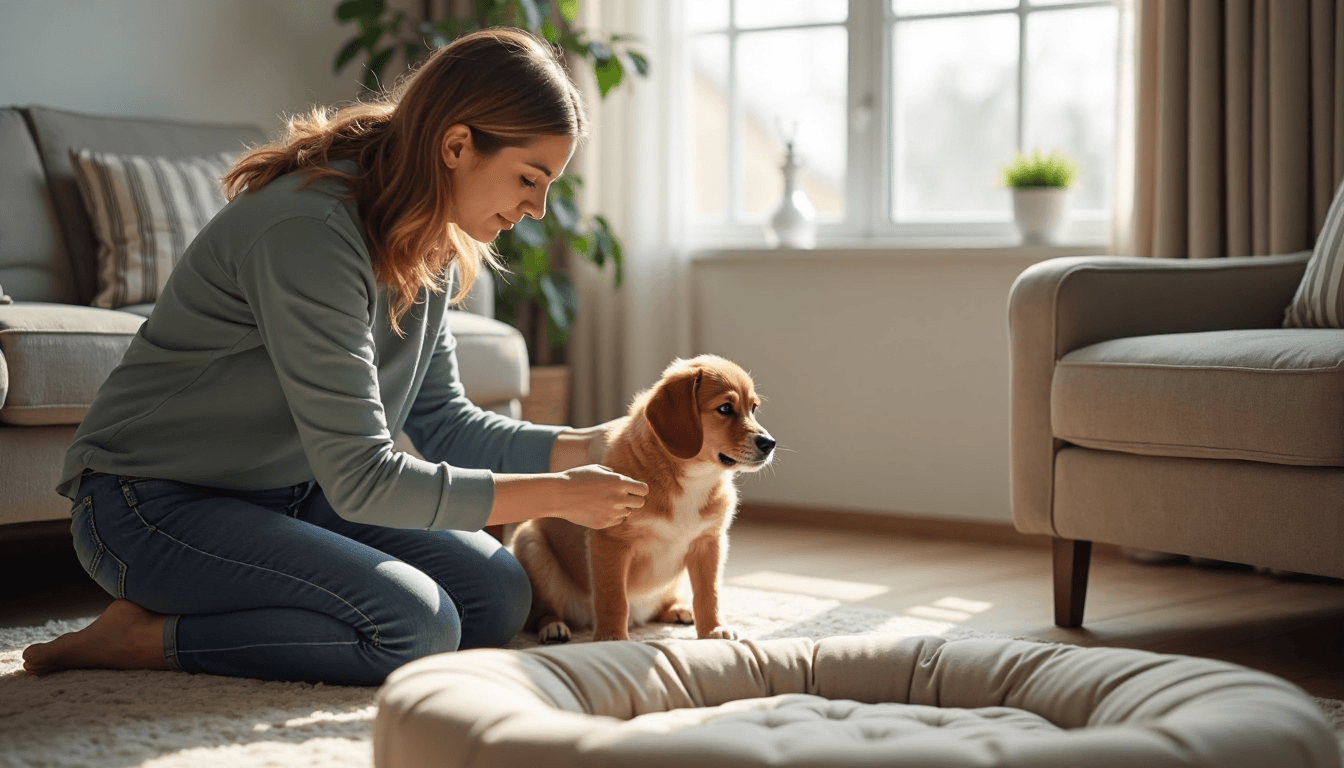
Safety is not a one-time task but a continuous process. As your dog ages or your home environment changes, you’ll need to regularly reassess potential risks. Veterinary experts suggest conducting monthly safety inspections, paying special attention to:
- New furniture or home improvements
- Changes in household chemicals or cleaning products
- Your dog’s evolving mobility and health needs
Consider installing safety devices like non-slip mats, protective corner guards, and using child-proof latches on cabinets. For dogs with mobility issues or specific health concerns, additional accommodations might be necessary to prevent accidents and ensure their comfort.
Remember that each dog is unique. What works for one pet might not be ideal for another. Observe your dog’s behavior, anticipate potential risks, and be prepared to adapt your safety strategies accordingly. By creating a thoughtful, well-designed living environment, you can significantly reduce the risk of accidents and provide your canine companion with a secure, comfortable home.
Outdoor Safety and Public Etiquette
Navigating public spaces with a dog requires careful attention to safety protocols and social considerations. Responsible dog ownership extends far beyond your home environment and demands a proactive approach to managing your dog’s behavior and interactions in shared community spaces.
Understanding Leash Laws and Public Space Dynamics
Leash management is fundamental to outdoor safety. According to the American Kennel Club, local jurisdictions typically have specific regulations governing dog management in public areas. These laws are designed to protect both dogs and humans from potential accidents or confrontations.
Key Leash Guidelines Include:
- Keeping dogs on a standard 4-6 foot leash in most public areas
- Maintaining full control of your dog at all times
- Being aware of specific leash requirements in different environments like parks, trails, and urban settings
Explore our comprehensive guide on dog safety strategies to better understand these critical outdoor interaction principles. Professional trainers emphasize that consistent leash training helps prevent unexpected behaviors and potential conflicts with other dogs or people.
Navigating Social Interactions and Canine Communication
Public interactions require sophisticated social skills from both dogs and owners. The Humane Society highlights that dogs communicate through complex body language signals that owners must learn to interpret and respect.
Before allowing your dog to approach another dog or person, always:
- Ask the other party for explicit permission
- Read both dogs’ body language for signs of comfort or stress
- Be prepared to redirect your dog if signs of discomfort emerge
Additionally, the Centers for Disease Control recommends teaching dogs basic obedience commands like “sit,” “stay,” and “come” to manage interactions effectively. These commands provide critical control mechanisms in potentially unpredictable public environments.
Environmental Awareness and Health Considerations
Outdoor safety extends beyond social interactions to include environmental hazards. Veterinary experts recommend considering several critical factors:
- Temperature management during walks
- Hydration and water availability
- Potential exposure to toxic plants or substances
- Wildlife and potential predator interactions
During warm weather, avoid walking dogs on hot surfaces like asphalt, which can reach temperatures significantly higher than air temperature. Research shows that surface temperatures can burn dog paws within seconds, potentially causing serious injury.
Ultimately, successful outdoor safety and public etiquette stem from consistent training, keen observation, and a commitment to responsible dog ownership. By understanding and respecting both your dog’s needs and those of the surrounding community, you create a safer, more enjoyable experience for everyone involved.
Special Considerations for Service and Senior Dogs
Service and senior dogs require unique approaches to care, safety, and support. These special canine companions demand heightened awareness, tailored strategies, and compassionate understanding to ensure their well-being and quality of life.
Understanding Service Dog Requirements
Learn more about service dog behavior and support to comprehend the intricate roles these remarkable animals play. Service dogs are not just pets but highly trained professionals who provide critical assistance to individuals with disabilities.
According to the Americans with Disabilities Act, service dogs are working animals trained to perform specific tasks for people with disabilities. These tasks might include guiding individuals with visual impairments, alerting people with hearing disabilities, supporting those with mobility challenges, or providing psychiatric support.
Key Considerations for Service Dog Interactions:
- Never pet or distract a service dog without handler permission
- Understand that service dogs are working and require focused attention
- Respect the dog’s professional role and the handler’s independence
The Department of Justice emphasizes that service dogs are not required to wear specific identification and can accompany their handlers in most public spaces, including restaurants, stores, and public transportation.
The following table summarizes service dog requirements and etiquette for public interactions:
| Requirement / Etiquette | Description |
|---|---|
| Handler Permission | Always ask before approaching/petting a service dog |
| Respect Working Status | Do not distract the dog; it must stay focused on its tasks |
| Identification | Service dogs are not required to wear special vests or tags |
| Public Access Rights | Allowed in most public spaces (restaurants, stores, transportation, etc.) |
| Respect Handler’s Independence | Avoid offering unsolicited help; interact directly with the handler |
Healthcare and Wellness for Senior Dogs
Senior dogs experience unique health challenges that require proactive and specialized care. Veterinary research indicates that dogs are typically considered seniors around 7-10 years old, depending on their breed and size.
Critical health monitoring for senior dogs includes:
- Biannual veterinary check-ups
- Regular blood work and comprehensive health screenings
- Monitoring changes in mobility, appetite, and cognitive function
- Adjusting diet and exercise to match aging requirements
The American Veterinary Medical Association recommends tailored nutrition plans that address age-related nutritional needs. Senior dogs often require lower-calorie diets with increased nutrients that support joint health, cognitive function, and overall wellness.
Adaptive Care and Support Strategies
Both service and senior dogs benefit from environments and approaches that prioritize their specific needs. Canine health experts suggest implementing adaptive strategies such as:
- Providing orthopedic bedding for comfortable rest
- Using ramps or stairs to help with mobility
- Creating consistent, predictable routines
- Maintaining mental stimulation through gentle interactive activities
For service dogs, ongoing training and mental engagement remain crucial. Handlers should continue reinforcing skills and providing opportunities for both work and relaxation. Senior service dogs might require modified training approaches that accommodate potential physical limitations while maintaining their professional capabilities.
Ultimately, caring for service and senior dogs demands patience, understanding, and a commitment to their unique requirements. By recognizing their individual needs and providing compassionate, specialized support, owners can ensure these remarkable animals continue to live fulfilling, comfortable lives with dignity and purpose.
Emergency Preparedness and First Aid Basics
Emergency preparedness is a critical aspect of responsible dog ownership that can mean the difference between life and death in unexpected situations. Being equipped with knowledge, skills, and essential resources allows dog owners to respond quickly and effectively during medical emergencies or disaster scenarios.
Creating a Comprehensive Emergency Kit
The Centers for Disease Control and Prevention recommends assembling a comprehensive emergency kit for your dog that goes beyond basic supplies. This preparedness strategy ensures you can provide immediate care and support during unexpected circumstances.
Essential Emergency Kit Components:
- Two-week supply of food and water
- Photocopied veterinary medical records
- Prescription medications
- Portable first aid supplies
- Copies of identification documents
- Recent photographs of your dog
Explore our comprehensive guide on dog safety strategies to understand how to develop a robust emergency preparedness plan tailored to your specific needs.
Critical First Aid Skills and Techniques
According to the American Veterinary Medical Association, understanding basic first aid techniques can significantly improve your dog’s chances of survival during medical emergencies. Professional veterinarians emphasize the importance of remaining calm and knowing how to perform critical interventions.
Key first aid skills include:
- Recognizing signs of distress
- Performing canine CPR
- Treating wounds and controlling bleeding
- Managing choking incidents
- Identifying and responding to heatstroke
The Red Cross Pet First Aid Guidelines recommend taking a professional pet first aid course to gain hands-on experience and confidence in emergency scenarios.
Disaster and Evacuation Planning
Comprehensive emergency preparedness extends beyond immediate medical interventions to include broader disaster planning. Emergency management experts advise creating a detailed evacuation plan that considers various potential scenarios such as natural disasters, home emergencies, or sudden health crises.
Critical evacuation preparation steps include:
- Identifying pet-friendly shelters in your area
- Establishing multiple transportation options
- Creating a network of potential pet caretakers
- Microchipping and maintaining updated contact information
- Practicing evacuation scenarios with your dog
Veterinary professionals recommend maintaining a “go bag” with essential supplies that can be quickly grabbed during emergency situations. This bag should contain portable water and food containers, a compact first aid kit, medications, and important documentation.
Ultimately, emergency preparedness is about anticipation, education, and quick, decisive action. By investing time in developing comprehensive skills and resources, dog owners can create a safety net that protects their beloved companions during unexpected and potentially life-threatening situations. Regular training, ongoing education, and maintaining updated emergency resources are key to effective preparedness.
Frequently Asked Questions
What are the essential home safety tips for dog owners?
Creating a safe home environment for dogs involves removing toxic substances, securing electrical cords, and creating designated safe areas for your dog. Regularly assess your living space for potential hazards as your dog ages or your circumstances change.
How should I prepare my dog for an emergency?
Assemble a comprehensive emergency kit that includes a two-week supply of food and water, medical records, and first aid supplies. Familiarize yourself with first aid techniques and develop a detailed evacuation plan that accounts for various emergencies.
What should I do to ensure my dog is safe outdoors?
Keep your dog leashed in public areas according to local laws, and maintain control over your dog at all times. Be mindful of your dog’s behavior and social cues to ensure safe interactions with other dogs and people in shared spaces.
How can I support the unique needs of service and senior dogs?
Service and senior dogs require tailored healthcare and support strategies. Provide regular vet check-ups, adjust their diet, and consider adaptive care solutions like orthopedic bedding or ramps to accommodate mobility issues.
Keep Your Dog Safe and Give Them a Voice
Are you worried about missing critical safety cues or not being able to communicate with your dog when it matters most? This article highlights how preventable accidents can happen quickly, especially for service dogs, seniors, or even curious puppies. Every owner wants to create a safer home and outdoor environment, but standard solutions may not give your dog the ability to signal when they need help or attention. Giving your dog a way to alert you instantly can close the gap between awareness and action.
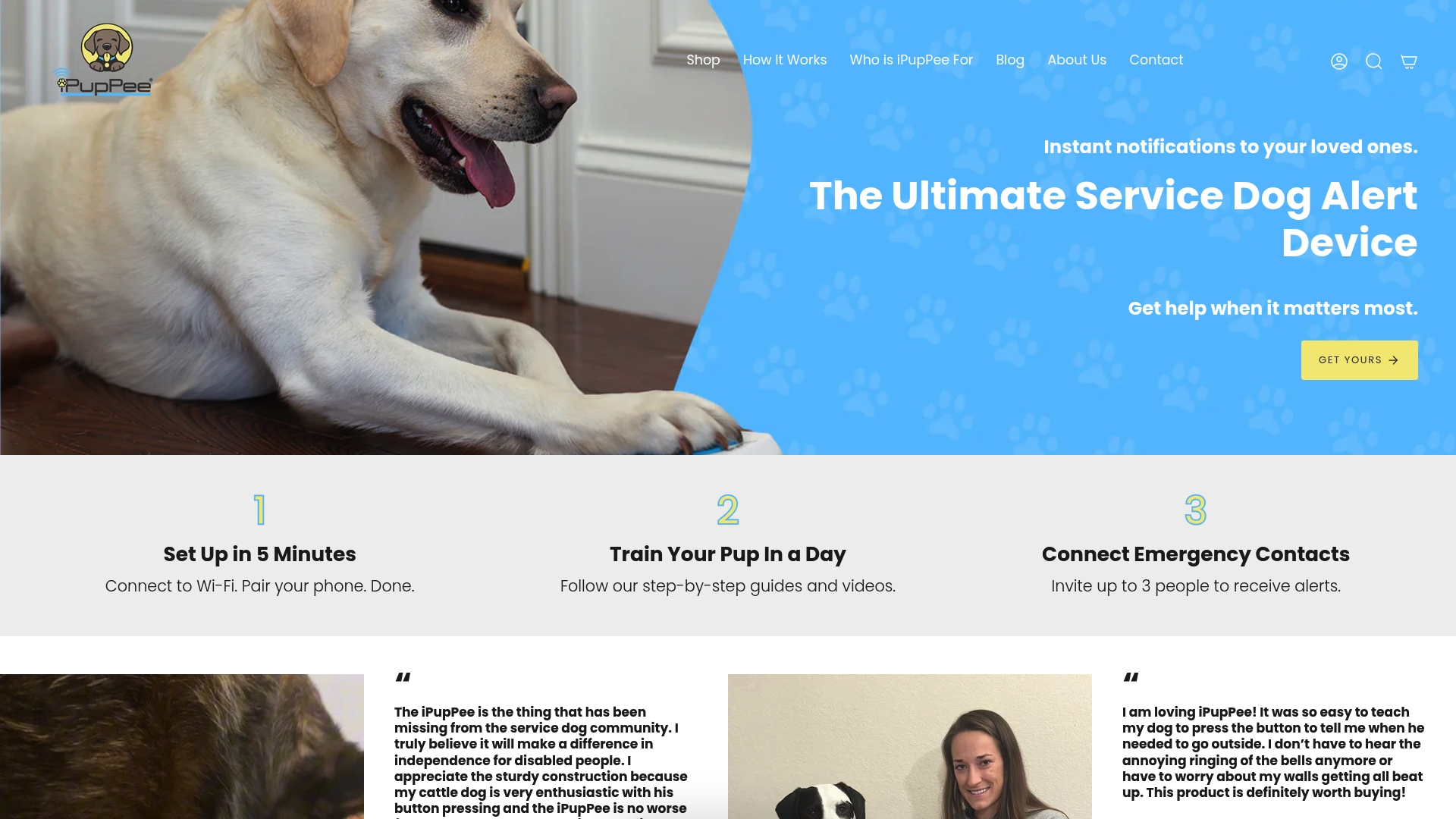
Discover how the iPupPee alert device can transform communication and safety for both you and your dog, no matter your unique situation. With just a simple press, your dog can alert you in real time, whether you have mobility challenges or just want extra peace of mind. Visit ipuppee.com to learn more about how this innovative solution can fit into your safety plan. Want more on empowering your dog to communicate? See our product details and training instructions to take the first step toward a safer, more independent life with your canine companion.

